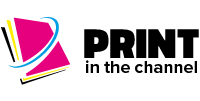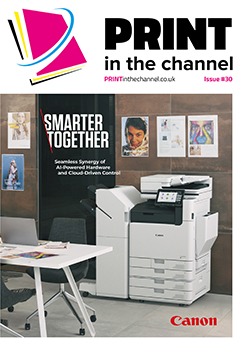As we head into 2024, there is optimism in the print sector for what the next 12 months holds, but a sense of realism that economic conditions mean that it won’t necessarily be easy.
With the Christmas and New Year break a rapidly fading memory, attention is now firmly on 2024 in the print channel and ensuring that this year brings new opportunities and chances for making a profit.
After a year of relative economic stability – even if there was generally little to no growth – and the problems in the supply chains of 2022 unwinding, resellers can focus on what they do best: selling and providing services to customers.
The economy will have an impact, with many employers looking for their print stock to be as efficient as possible – but for forward-looking resellers there are opportunities there to help businesses to do that.
Allied to that, there are other things to look forward to. For instance, the developments in artificial intelligence (AI) will have an increasing impact on the sector – especially with increasing efficiency – as well as the continued movement of businesses towards cloud printing.
There will also be a continuing focus on sustainability, as pressures on businesses in all sectors to reduce their impact on the environment grows – and the print and document management sectors will have their part to play in this.
Here, a range of thought leaders from across the print sector give their opinions on what 2024 holds for their business and the wider print sector.
Michael Field, founder and chief executive, Workflo Solutions
As we look forward to 2024, we at Workflo Solutions are optimistic about the prospects for our business and the broader print channel. The managed print industry in the UK has shown resilience, adapting to challenges and emerging stronger. We believe that the coming year will bring opportunities for innovation and growth.
Recent advancements in inkjet technology offer exciting opportunities in the production print space, particularly in transactional mail and high-volume environments where quality isn’t the prevailing consideration.
Anticipating major trends in the sector, we foresee an increased emphasis on sustainable and cost-effective solutions. Businesses will continue to seek ways to streamline their operations and managed print services will play a pivotal role in achieving efficiency and reducing environmental impact. We shall remain committed to providing cutting-edge solutions that align with these evolving trends, ensuring our clients stay ahead in a dynamic market.
If one were to take 2023 as a precursor to 2024, it’s clear that economic pressures, particularly those driven by the increased cost of funds following each Bank of England base rate increase, will likely continue into 2024. I expect a steadying of this, although I don’t expect a reduction in the first half of the year. When considering further economic pressures, the cost of living crisis will play a big part as businesses strive to support staff, this will inevitably lead to squeezed margins as they increase salaries to ease the pressure felt by employees. We recognise the significance all of this holds in influencing buying decisions within the managed print industry.
In terms of disruptive technologies, we anticipate that AI will significantly influence the managed print industry in 2024. Intelligent automation and machine learning will enhance print workflows, providing predictive maintenance, automated supply replenishment and personalised user experiences, but it also has the potential to drive print volumes down quickly. Time will tell on this one.
Additionally, we foresee advancements in cloud-based printing solutions and document management. As businesses increasingly adopt remote and hybrid work models, the demand for flexible and secure printing solutions will surge. Workflo Solutions will maintain its investment strategy in cloud migration and document management so we’re ready to address these evolving technological needs with integrating AI into our solutions. I expect that other forward thinking service providers will do the same.
Richard Wells, Head of office print sales UK & Ireland, Epson
We have a strong sense of optimism for the business and the print channel in 2024 and beyond. We’ve started the year on a high, having recently announced Epson’s transition to 100% renewable energy across its global sites, and the increasing demand from customers for sustainable printing through reduced energy consumption and waste continues to be met with our WorkForce Enterprise AM-C series and our EcoTank range.
Looking at the trends I foresee in 2024, the first is the continued supply and demand of sustainable solutions, where businesses are demanding more environmental results and vendors are increasingly having to walk the talk. The second is identifying the perfectly balanced deployment of printing, as businesses progress further with optimising their hybrid working environments.
Then as acquisitions, mergers, and the rise of as-a-service offerings become increasingly prevalent, it’s predicted that more businesses will strategically join forces in a bid for a stake in the market — it’s a trend I expect we will see growing throughout 2024.
But the economic climate in 2024 will likely play a big part in buying decisions, especially for the print sector. Ultimately, the cost-of-living crisis won’t be going anywhere imminently soon and so consumers and businesses alike will be looking to save costs wherever they can.
The ability to calculate reduced running costs will only increase in value for the copier industry, and our ability to do so with the Epson Optimisation Report based on switching from laser to inkjet is a highly future-proof benefit for resellers.
This is one reason we’ve seen increasing demand for cartridge-free EcoTank printers, as they offer a more cost-effective and environmentally friendly solution. But, with higher up-front costs the continuation of this trend in 2024 relies on companies like Epson and its channel partners communicating the cost savings to customers.
Steve Holmes, Head of global sales & channels/EMEA GM, Papercut
Broadly speaking, we’re quietly optimistic about 2024. Last year was bumpy for everyone, but we did see a market turnaround in the second half of 2023 and that brought with it a confidence that has spilled into the new year.
It’s likely that ESG goals and sustainability initiatives will be drivers for growth as companies assess their print fleet to establish whether its eco-performance is in line with their targets. Remember too, that many companies missed a print fleet refresh because devices were under used during the pandemic, so they kept their fleets for longer; those devices may not be as environmentally friendly as newer devices, so we expect to see a bit more movement on fleet upgrades this year. Now the chip crisis is almost over and the production of printers and MFPs is back to meeting market demand, replacing print fleets should be easier. And, given that demand for software solutions often mirrors that of demand for hardware solutions, I think the second half of the year should be quite buoyant.
I think we’ll also see the transition to cloud continue to pick-up pace. ‘Cloud first’ organisations are now becoming ‘cloud only’ organisations, and we’re seeing customers who weren’t embracing cloud become ‘cloud first’. As end users move to cloud, we also anticipate that end user demand for subscription offerings will increase, which, in turn, will kick-start a transition to subscription pricing models in 2024. As customer needs evolve and the transition to cloud gathers pace, naturally we’re working closer with our partners to help them deliver cloud-based solutions for their customers to make print easier and more secure, while delivering tangible value, ROI and sustainability benefits for today’s hybrid workforce.
I also believe that in 2024 we will continue to see a strong focus on security; not just because it’s a perennial, but because the threat landscape is ever evolving and AI alone could be used to unleash a new wave of threats we’ve not encountered before. Considering that, some verification processes may become more robust, but hopefully not at the expense of a positive user experience.
Where print security is concerned, we’ll see a greater adoption of modern authentication and MFA to get access to documents and systems, as well as how documents are transmitted and where and how they are stored; the latter will be especially important for government organisations. The now-normal hybrid work model – which requires robust security solutions, products and policies in order to mitigate risk as much as possible – will also shape security in the year ahead.
During these volatile times, almost every business is hanging onto the Chancellor’s and the Bank of England’s every word. It doesn’t take much to rock the financial markets, so companies will be looking closely at the value of the US dollar, interest rates, energy prices and global events that trigger interconnected shockwaves across the economy; for instance, we entered 2024 with trouble in the key Middle Eastern trade routes leading to longer shipping times and higher freight costs. Closer to home, one further thing to consider is the business caution usually shown in an election year. That may impact buying timeframes and purchasing decisions.
Finally, there’s no doubt that AI will dominate the tech landscape in 2024. I think we’ll see the conversation evolve from the risk posed by AI to AI safety, as fuelled by the AI Safety Summit hosted in the UK last November. We’ll see more discussions about putting technical and ethical AI guardrails in place as organisations learn to deploy the technology in a way that adds value by automating routine tasks without compromising safety. Like many organisations, PaperCut is establishing the best way to embrace AI and embed it into how we drive our daily business. We’re keen to understand how it can add value in areas such as support and self-help to further optimise the customer experience.
Trevor Maloney, Product marketing manager, Kyocera
In 2024, the outlook for our business and the print channel is highly optimistic. The industry is undergoing a transformative phase, with a strong focus on sustainability, security and technological advancements. The implementation of the Corporate Sustainability Reporting Directive is a significant catalyst, driving a cultural shift towards environmental responsibility. We are witnessing channel partners and vendors aligning with the UK’s net zero target, marking substantial progress towards becoming carbon-neutral businesses.
The major trends shaping the print sector in 2024 are likely to be centred around cybersecurity and sustainability, with products themselves becoming more eco-friendly. There’s a heightened emphasis on greener procurement and supply chains, encompassing packaging materials, shipping emissions and circularity. Vendors are supporting this shift by providing tools for environmentally conscious decision-making.
As cyberattacks rise businesses will prioritise their cybersecurity spend to mitigate risk. The introduction of the Product Security Telecommunications Infrastructure on April 29 this year will drive trust in the security of connected IoT devices with businesses already looking at security credentials when specifying IoT products – and this includes A4 printer and MFPs. Providers like Kyocera Document Solutions UK have already shifted to enable businesses to address the threat landscape head-on with a comprehensive suite of security solutions that include MFA, SEIM, back-up and disaster recovery, plus their flagship security service Managed Endpoint Detection and Response.
The state of the economy will wield a significant impact on buying decisions. While economic stability fosters confidence encouraging an uptick in spending, an economic downturn may put capex expenditure under the microscope as businesses ensure they get the best bang for their buck.
Flexibility and strategic adaptation to economic conditions will therefore be crucial for businesses in the print industry to navigate and thrive in the dynamic market of 2024.
In 2024, the Kyocera TASKalfa Pro 55000c is poised to disrupt the production print market with its innovative inkjet technology. This device achieves offset-quality printing, supporting coated paper for brochures, books and direct mail. Leveraging Kyocera’s 1,200dpi inkjet heads and edge smoothing technology, it ensures smooth colour reproduction and high-definition printing. The Pro 55000c not only meets the industry’s demand for image resolution, but also reduces total cost of ownership in commercial printing. Its eco-friendly approach, utilising water-based inks, also aligns with sustainability trends.
Arjan Paulussen, managing director, Western Europe & English-speaking Africa, Lexmark
We at Lexmark are cautiously optimistic about 2024. The office technology landscape is undergoing a period of significant transformation, driven by rapid advancements in technology and shifting business priorities. The channel market, which plays a crucial role in connecting manufacturers with end users, faces numerous challenges as it navigates this dynamic environment. However, these challenges also present opportunities for growth and innovation, especially in the realm of sustainability, enabling forward-thinking dealerships to differentiate themselves from the competition and thrive in the years ahead.
The state of the economy always plays a big role for our B2B customers. Persistent inflation continues to be a challenge and companies are more thoughtful where investments are allocated. At the same time, investments that drive savings, whether these savings are monetary or in the form of efficiency improvements or for example sustainability benefits, will always jump to the front of the queue. It does call on us, as well as the channel partners that we work with, to lead with these benefits first and foremost.
In terms of trends in the sector in 2024, from embracing cloud services and infrastructure to developing industry-specific solutions – harnessing the power of AI, big data, analytics and prioritising security and data privacy – the office technology dealerships of the future must be agile, customer-centric and innovative.
Sustainability is another major trend that the print channel will need to continue to focus on. This is where Lexmark’s ‘intentional engineering’ strategy comes into play. Our devices are built to last seven plus years at minimum; thanks to their robustness they can stay longer in the field. This helps to minimise the impact on the environment as fewer devices need to be remanufactured, recycled or disposed of.
AI will continue to play a significant role in modern office technology, enabling dealerships to automate routine tasks, analyse large volumes of data, and provide personalised experiences for their clients. For example, AI-powered predictive maintenance algorithms can help dealerships proactively identify potential issues with printing devices, allowing them to address problems before they impact customers. Additionally, AI-driven analytics can help dealerships uncover hidden patterns and trends in their data, leading to more informed decision-making and improved business outcomes.
Stuart Sykes, managng director, Sharp UK
I expect there to be several major trends in the sector this year. Firstly, there will be greater automation of print processes. While automation of processes within organisations is nothing new, streamlining workplace tasks is a trend that delivers efficiency for the employer and employee. The removal of manual steps from routine operations speeds up productivity, reduces overall costs, while at the same time enabling employees to focus on business development.
MFPs still have a role to play in the automation of many organisations, as often there is content in analogue form that needs to be digitised through workflow processes. This is a trend that continues to gather traction with clients, as they move away from centralised processes in favour of custom workflows. Tools are now available to enable even the smallest of organisations to automate manual and laborious tasks with ease.
As with many of the trends we are seeing, this will only become easier with the use of AI. Until recently, process automation was a very expensive thing to indulge in, requiring consultancy and a bespoke build and configuration. The application of AI simplifies process and workflow automation, taking a standard platform and personalising it to a specific client in a cost-effective manner.
The print industry in Europe is seeing new sustainability regulations introduced, either as draft proposals to give manufacturers time to prepare, or as laws taking effect. One area in which the industry is seeing change is in that of remanufactured or refurbished devices. IDC research suggests that by 2027, global enterprises will seek to shift 10% of their fleet acquisitions to remanufactured or refurbished devices. While this trend is very much focused on enterprise level volumes of print devices, we do expect the trend to move to small and medium-sized businesses seeking to save money and improve sustainability.
Clients typically look to refresh their print solutions every five years on average. However, as print volumes continue to decline the natural life of devices can be extended without any disadvantage to service or efficiency. The remote monitoring and management of print devices in these situations will be key to helping reduce costs, waste and extend lifecycle expectations.
There is no getting away from the fact that for the most part ‘print’ is a mature technology. Print speeds can be improved, efficiencies around power usage can be made but the underlying technology remains the same. Therefore, innovation within print tends to be incremental and is often about creating more cost-effective devices, whether that is in the cost of purchase, or in maintenance costs. This is even more true as hybrid working has become the norm.
However, A3 devices will not be going away any time soon, as they still play a major role within many organisations. The trend we are seeing is that the number of centralised large workgroup A3 devices are reducing as organisations adjust to the new norms of the modern workplace. As a result, A4 devices with similar feature sets will become more common for smaller teams.
Cloud as a technology is nothing new and migration to cloud-based services is no longer seen as a trend. Rather, how organisations make the most of the cloud services they have, and those they use, are seen as the growth areas.
It’s important that organisations create the right workflows for data access, especially in the age of AI where information can be filtered and accessed far more quickly than before. If the right data structures with the right levels of authorisation are not put in place, data breaches can quickly occur.
Elsewhere in 2024, the proliferation of AI use is staggering and is set to be one of the fastest paces of change within the history of IT. For context, cloud has taken a decade to become established, but AI will achieve the same level of adoption, pervasiveness and impact in 12 months. One thing is clear, the trend for its use within organisations will only grow going forward.
On a print device level, we will start to see trends around AI simplifying and personalising the use of technology within a organisations, reducing the number of steps to accomplish a print task as an example.
For more complex processes around digitisation we are already seeing AI being used to contribute to document capture and workflows. Processes such as manual classification and information extraction from documents is no longer a laborious task as AI is taking over many of those roles.
While AI can bring real benefits to an organisation, it also increases threats from bad actors. Hackers are already exploiting AI technology to their own advantage and organisations need to be prepared.
It’s imperative that print vendors and clients stay aware of AI developments from a cloud and print security point of view. This means regularly evaluating processes and technology to make sure that print security strategy is fit for purpose.
Mike Faiers, chef technology officer,
Konica Minolta Business Solutions (UK) Ltd
As the workplace continues to evolve and change, we are likely to see further reliance on technology and smarter ways of working that take advantage of automation benefits.
With global unrest and continuing economic pressures, along with long-term challenges such as the deepening climate emergency and globally aging population, flexible and sustainable working practices have never been more important.
This is why Konica Minolta is passionately committed to supporting the evolution of the digital workplace through our Intelligent Connected Workplace portfolio, which is designed to address all these needs from a single expert supplier, enabling organisations to concentrate on their core activities with full peace of mind.










